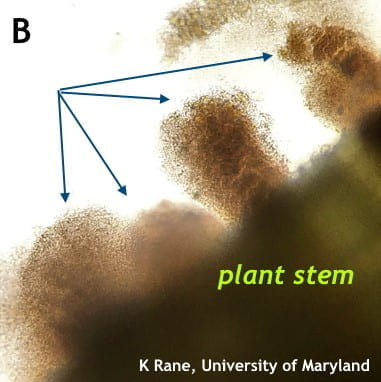Jerry Brust, IPM Vegetable Specialist, University of Maryland; jbrust@umd.edu
Southern bacterial wilt of tomato, which is caused by the soil-borne bacterium Ralstonia solanacearum Race 1, has been found in a couple of tomato fields in the past week. This pathogen affects many solanaceous crops and is found throughout the southern United States.
The pathogen enters plant roots through small wounds such as those caused by insects, nematodes, cultivation, or transplanting. The bacteria then multiply in the vascular system, eventually clogging the water conducting vessels with bacterial cells and slime which prevents water and nutrients from moving throughout the plant. Initially, infected plants develop wilt symptoms in the afternoon, and recover in the evening. Symptoms can develop quickly, especially when fruit is rapidly expanding, or when temperatures are 85-95o F and moisture levels are high. As the disease progresses, the base of the plant may show brown cankers, root rot, and a section of an infected stem may show a brown discoloration of the vascular tissue (Fig. 1). The plant eventually becomes permanently wilted and death occurs. A freshly cut stem at the base of the plant placed in water can show a stream of a white slimy substance (Fig. 2A) that is a strong indicator of the bacterium present in the vascular tissue (Fig. 2B). The interior of the stem also can be a dark or light brown in the pith area (Fig. 3).
Bacterial wilt is difficult to manage once present in the field. There are no chemical controls that provide effective management. This disease can be introduced into fields through infected transplants, water runoff from adjacent contaminated fields, or movement of tools and equipment containing infested soil. Weeds can serve as alternative hosts for this pathogen, so weed control is important in disease management. Crop rotation (for at least 4 years) and planting cover crops of non-susceptible plants (i.e., corn, beans, cabbage) may help reduce populations of the pathogen in the soil. Growers can use tomato plants grafted with bacterial wilt resistant rootstocks in fields where bacterial wilt is present. A list of resistant rootstocks is available on the USDA tomato rootstock page and includes such examples as Armada, Bowman and RST-05-113-TE rootstocks.

Figure 1. Tomato stem infected with R. solanacearum, split in half, showing discolored vascular tissue (yellow arrow) and pith (blue arrow).

A freshly cut stem at the base of the plant placed in water can show a stream of a white slimy substance

Figure 2. Bacterial slime streaming out of a cut stem in glass of water (A) and Bacteria streaming out of infected xylem tissue (arrows), viewed under a microscope at 100X (B).

Figure 3. Discolored pith at the base of an infected tomato stem
